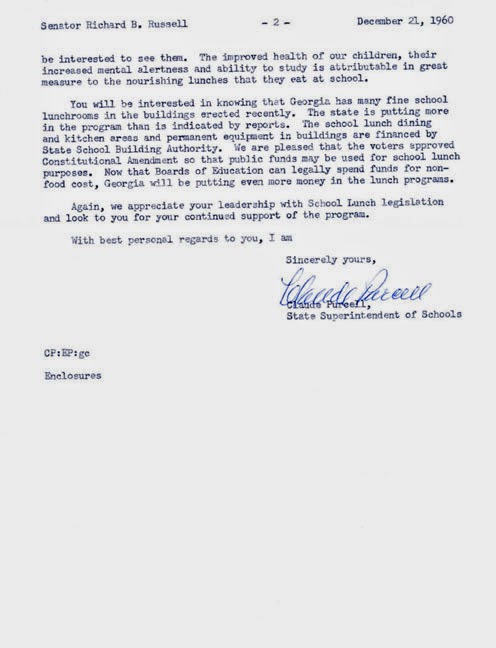Over the past two summers Russell Library interns Ashton Ellett and Kaylynn Washnock assisted in curating the new exhibit, “Food, Power, and Politics: The Story of School Lunch” opening September 26th in the Russell Library’s Harrison Feature Gallery. The exhibit examines the complicated past of the National School Lunch Program, from feeding malnourished children and putting excess commodities to good use, to the more recent debates over childhood obesity and nutrition in America. This post is one in a series where Ashton and Kaylynn provide a preview of key documents featured in the exhibition.
 |
Chart showing participation of Georgia schools in
NSLP from 1943-1960. Richard B. Russell Collection, Russell Library. |
With participation in the school lunch program growing during the 1950s, local administrators felt constant financial pressure. During the 1943-1944 school year just over 1,000 Georgia schools took part; by 1960, this number of participating schools had increased to nearly 1,800. These Georgia schools served an average of 500,000 meals per day -- 9 million meals per month. Despite this growth, the funding for the program was based on the decade old data.
On December 28, 1960 Claude Purcell, state superintendent of schools, wrote to Senator Russell about proposed amendment HR 12896. Given the National School Lunch Program’s success in Georgia, Purcell was especially concerned with the government’s reimbursement rate for school lunches. He hoped to see the reimbursement rate increase from 3.6 cents to 5 cents per meal, so that the price of the meal for paying students would not have to be raised, fearing any increase would force more students into the free or reduced lunch. As Senator Russell noted in his response, Congress did not pass the amendment. (See letter exchange below).
 |
|
 |
|
 |
|
Several amendments to the National School Lunch Act (NSLA) in 1962 sought to improve the under representation of low-income participants in the program. However, Congress did not appropriate additional funding to make these reforms a reality until the passage of the Childhood Nutrition Act (CNA) in 1966, which expanded institutional eligibility and enacted a pilot breakfast program. The consequences of making good on the mandate would steer the program into uncharted territory in the following decades as school lunch transformed from a farm subsidy into an antipoverty program.
Want to find out more about School Lunch? Visit
Food, Power, and Politics: The Story of School Lunch on display in the
Harrison Feature Gallery in the
Richard B. Russell Building Special Collections Libraries from September 26, 2014 through May 15, 2015. The Russell Library gallery is free and open to the public weekdays from 8 a.m.-5 p.m. and on Saturdays from 1-5 p.m. For more information, email
russlib@uga.edu or call 706-542-5788.








No comments:
Post a Comment